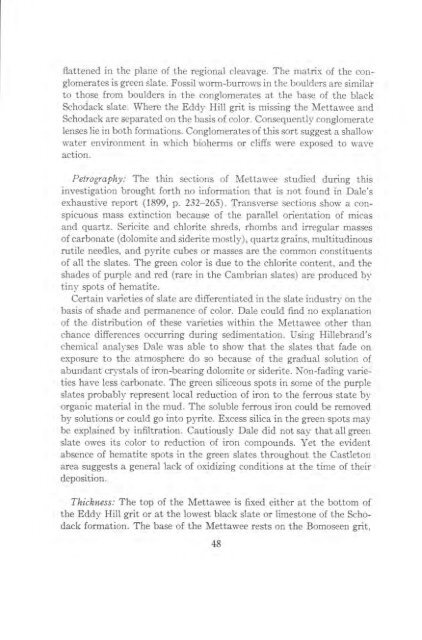STRATIGRAPHY AND STRUCTURE CASTLETON AREA VERMONT
STRATIGRAPHY AND STRUCTURE CASTLETON AREA VERMONT
STRATIGRAPHY AND STRUCTURE CASTLETON AREA VERMONT
Create successful ePaper yourself
Turn your PDF publications into a flip-book with our unique Google optimized e-Paper software.
flattened in the plane of the regional cleavage. The matrix of the conglomerates<br />
is green slate. Fossil worm-burrows in the boulders are similar<br />
to those from boulders in the conglomerates at the base of the black<br />
Schodack slate. Where the Eddy Hill grit is missing the Mettawee and<br />
Schodack are separated on the basis of color. Consequently conglomerate<br />
lenses lie in both formations. Conglomerates of this sort suggest a shallow<br />
water environment in which bioherms or cliffs were exposed to wave<br />
action.<br />
Petrography: The thin sections of Mettawee studied during this<br />
investigation brought forth no information that is not found in Dale's<br />
exhaustive report (1899, p. 232-265). Transverse sections show a conspicuous<br />
mass extinction because of the parallel orientation of micas<br />
and quartz. Sericite and chlorite shreds, rhombs and irregular masses<br />
of carbonate (dolomite and siderite mostly), quartz grains, multitudinous<br />
rutile needles, and pyrite cubes or masses are the common constituents<br />
of all the slates. The green color is due to the chlorite content, and the<br />
shades of purple and red (rare in the Cambrian slates) are produced by<br />
tiny spots of hematite.<br />
Certain varieties of slate are differentiated in the slate industry on the<br />
basis of shade and permanence of color. Dale could find no explanation<br />
of the distribution of these varieties within the Mettawee other than<br />
chance differences occurring during sedimentation. Using Hillebrand's<br />
chemical analyses Dale was able to show that the slates that fade on<br />
exposure to the atmosphere do so because of the gradual solution of<br />
abundant crystals of iron-bearing dolomite or siderite. Non-fading varieties<br />
have less carbonate. The green siliceous spots in some of the purple<br />
slates probably represent local reduction of iron to the ferrous state by<br />
organic material in the mud. The soluble ferrous iron could be removed<br />
by solutions or could go into pyrite. Excess silica in the green spots may<br />
be explained by infiltration. Cautiously Dale did not say that all green<br />
slate owes its color to reduction of iron compounds. Yet the evident<br />
absence of hematite spots in the green slates throughout the Castleton<br />
area suggests a general lack of oxidizing conditions at the time of their<br />
deposition.<br />
Thickness: The top of the Mettawee is fixed either at the bottom of<br />
the Eddy Hill grit or at the lowest black slate or limestone of the Schodack<br />
formation. The base of the Mettawee rests on the Bomoseen grit,<br />
48













